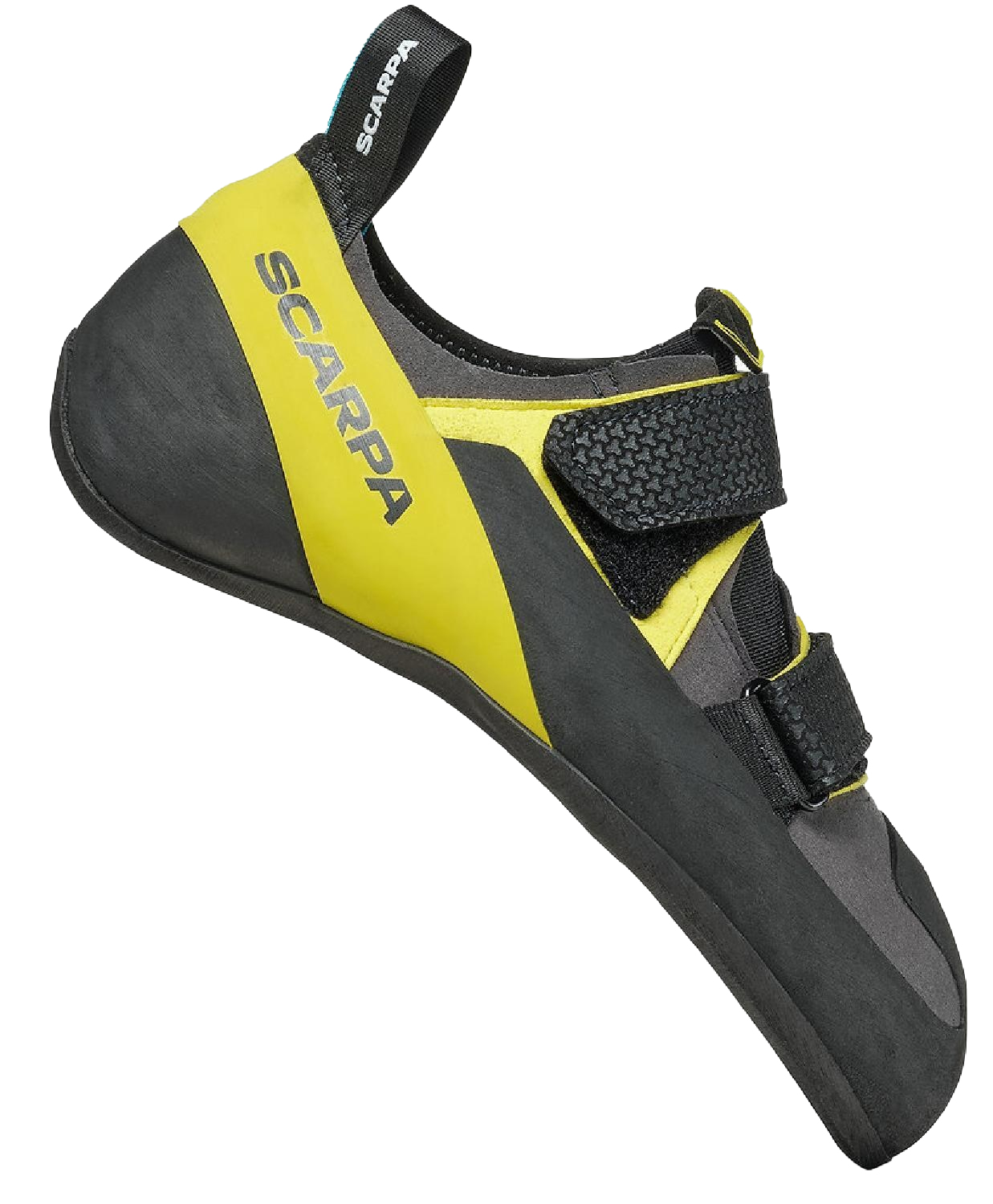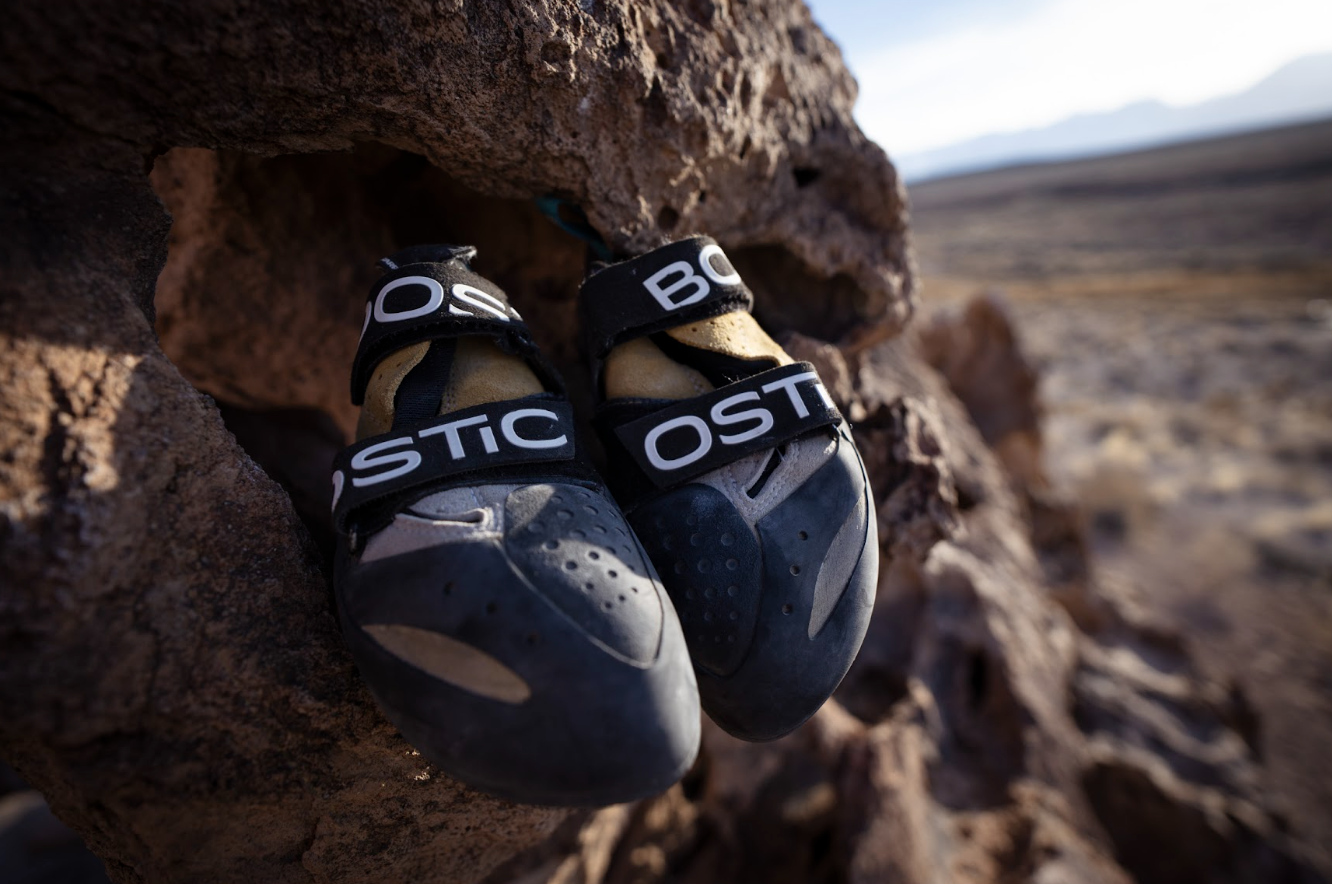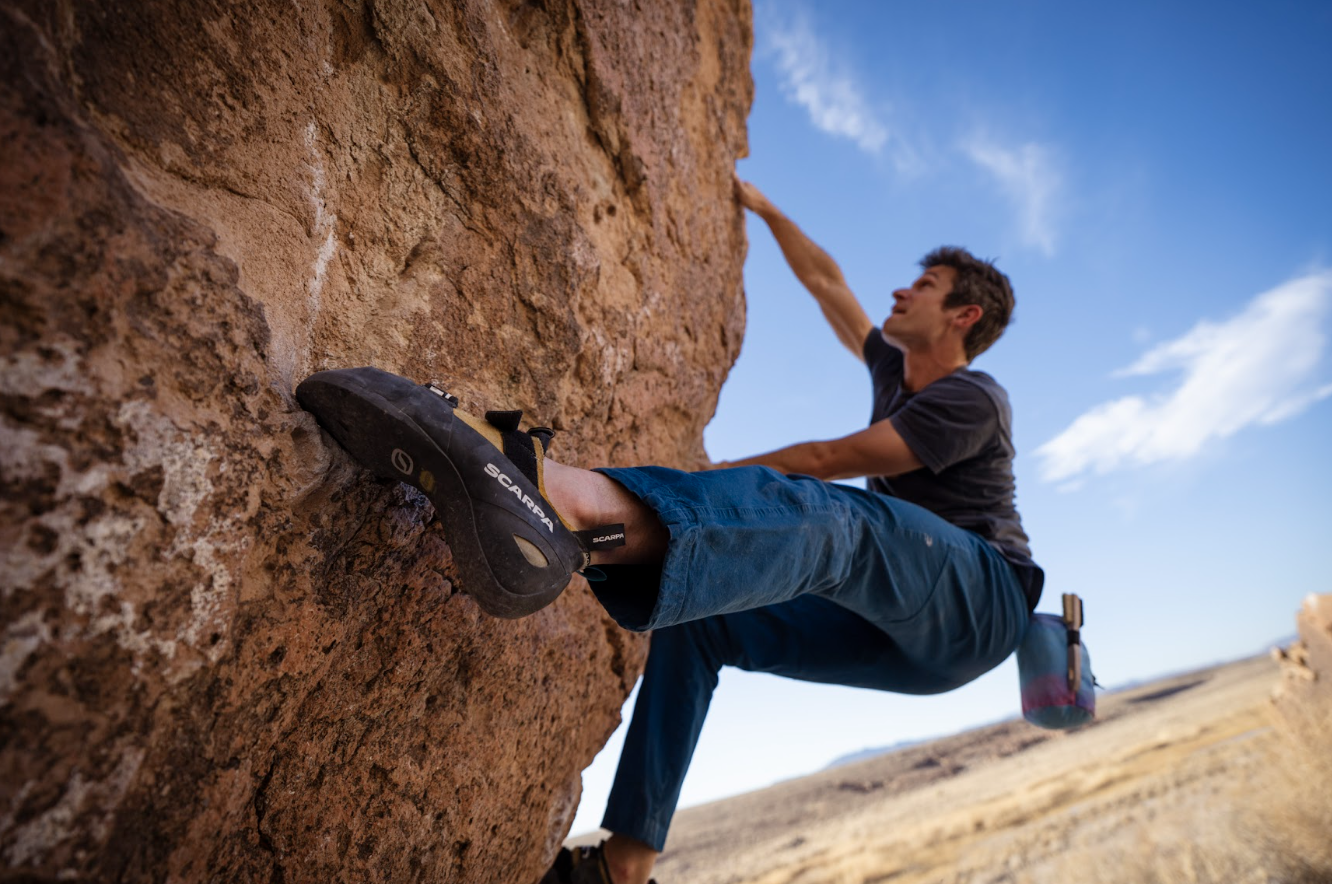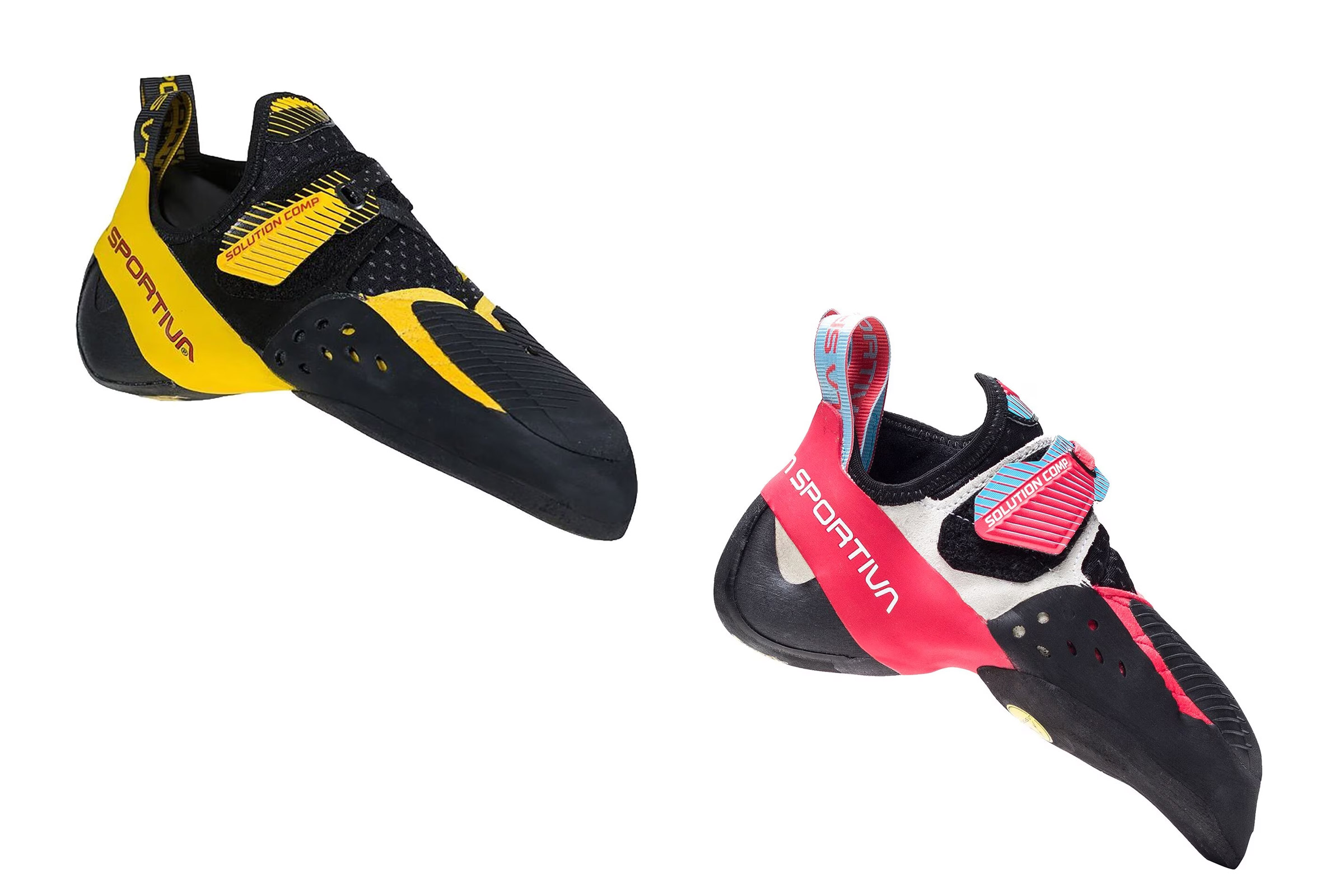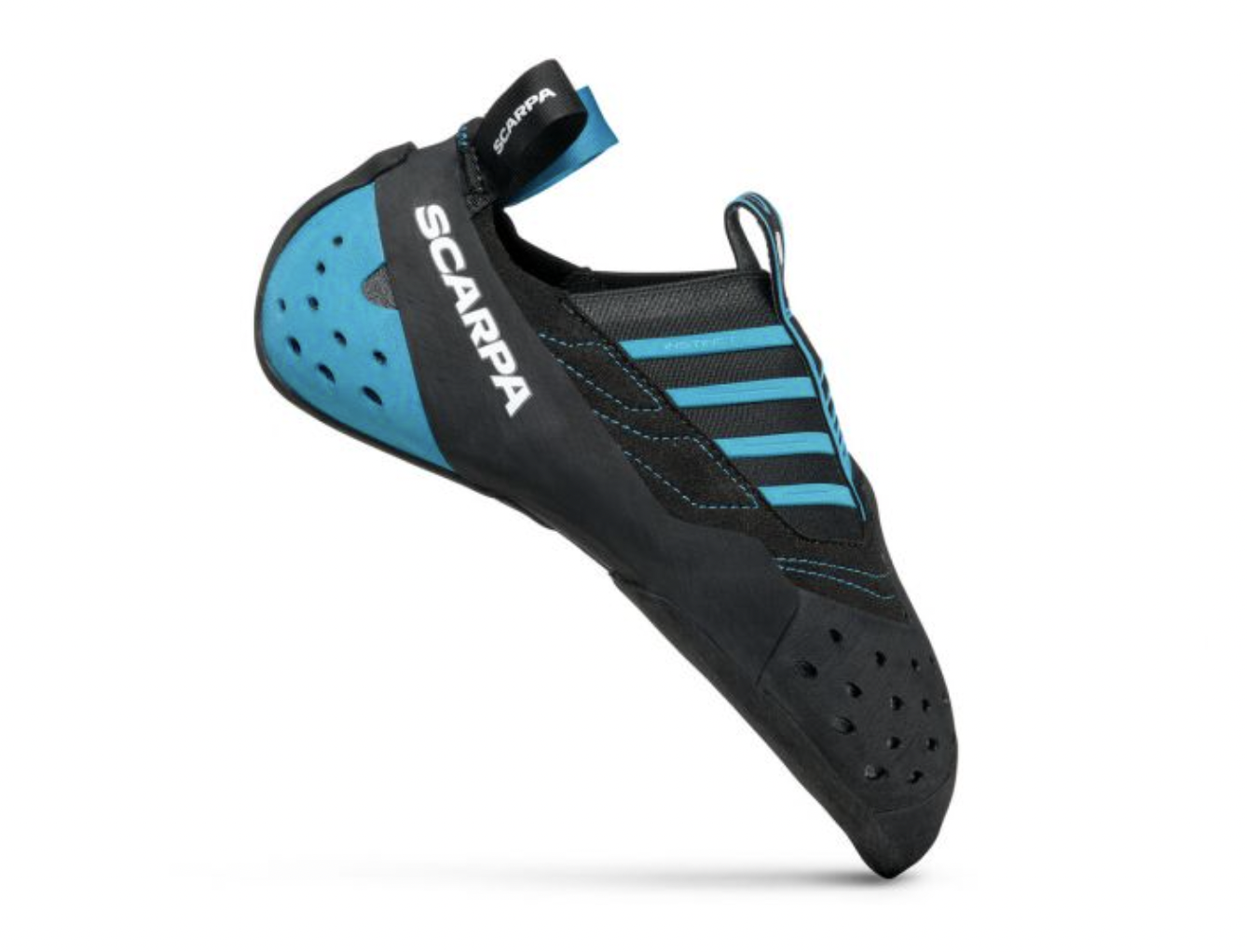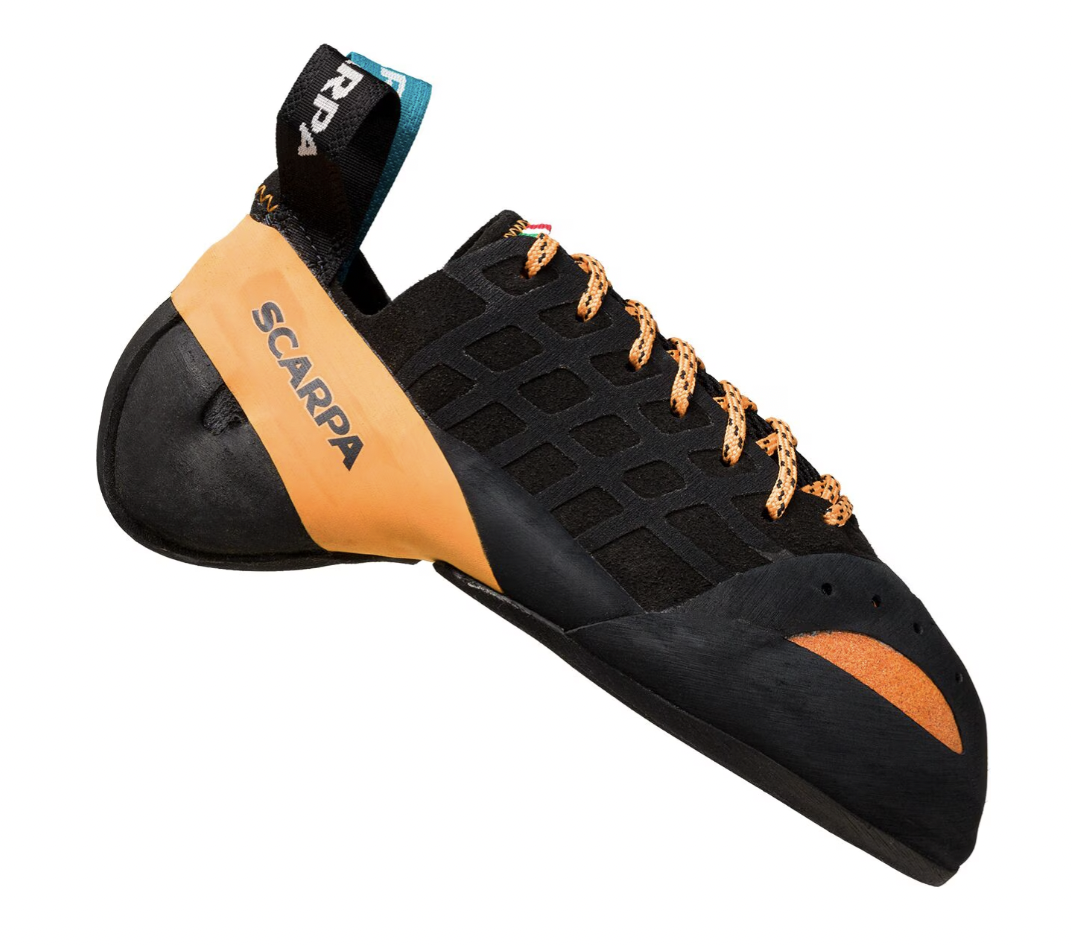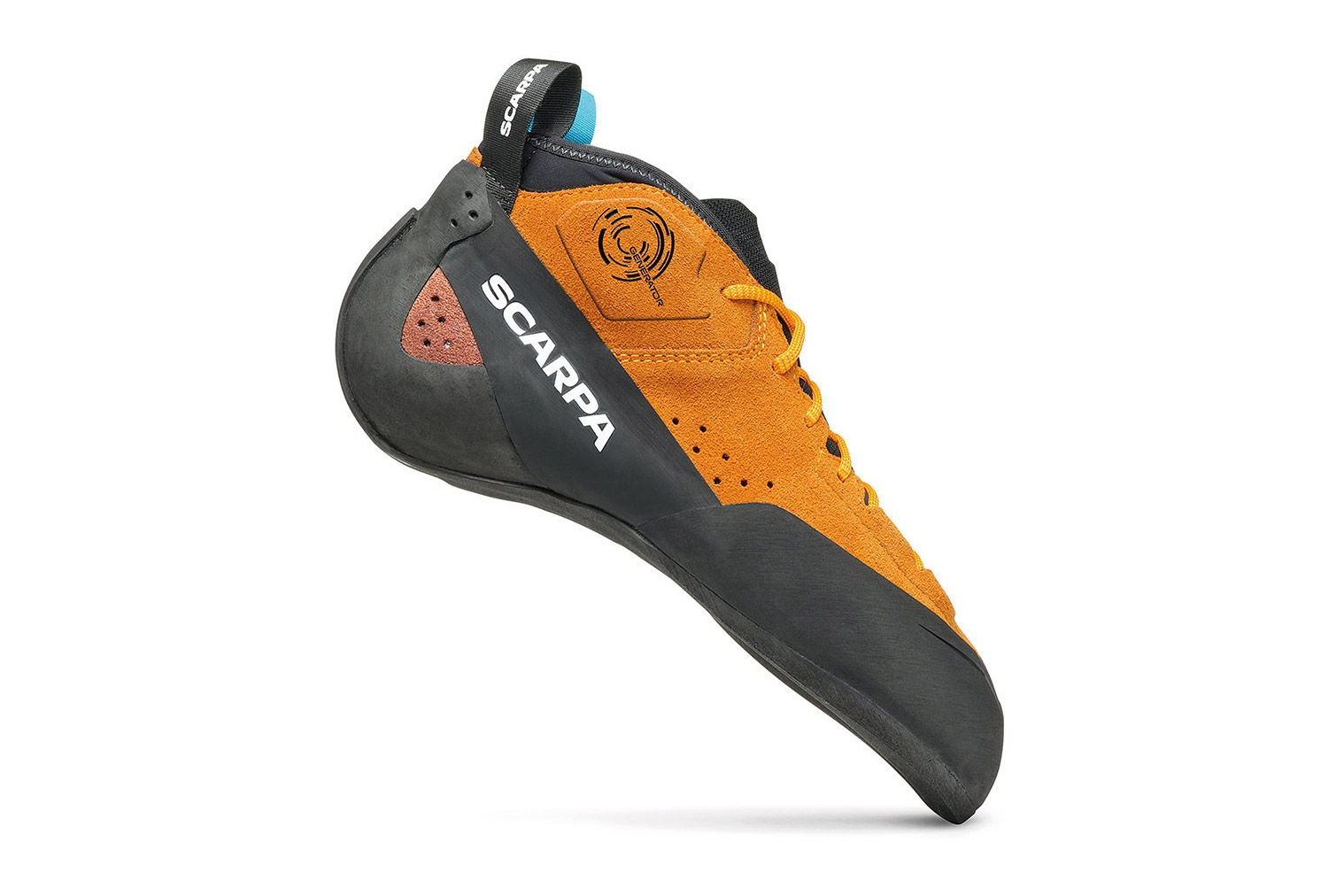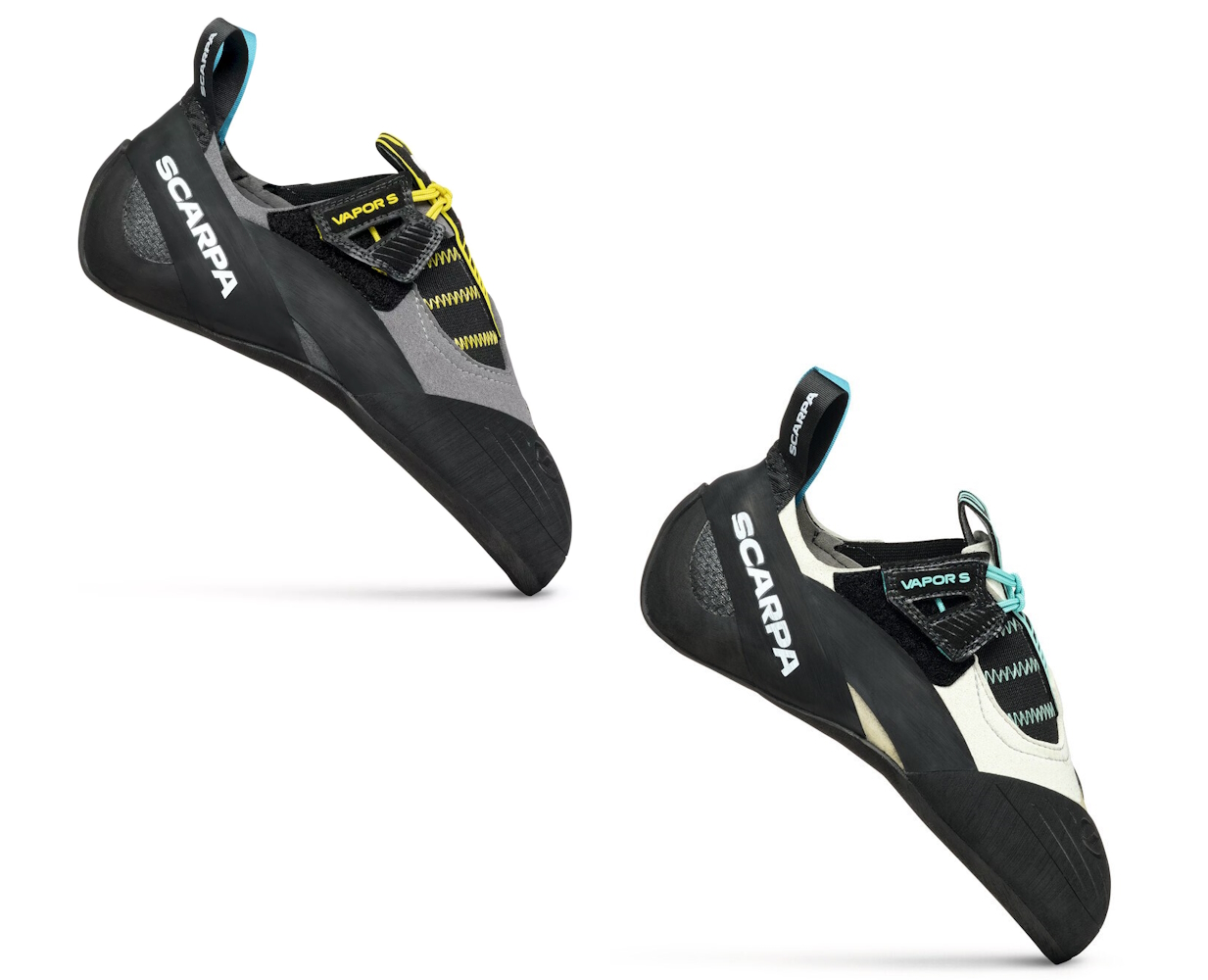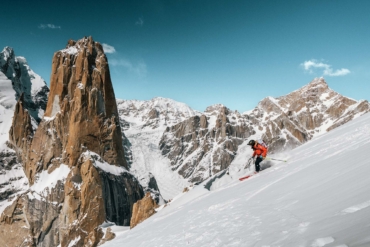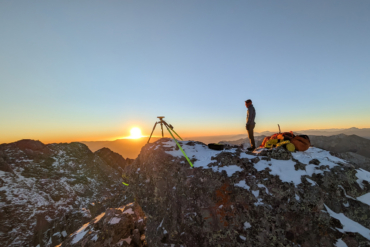As the popularity of climbing continues to surge, the demand for high-performance gear is greater than ever before. While a climbing rope and a bouldering crash pad are not required items for brand-new climbers, a pair of climbing shoes is essential from day one.
Our ongoing effort to test every climbing shoe on the market is led by GearJunkie writer Austin Beck-Doss and Editor Matt Bento. Austin is based in Lander, Wyo., where a lifetime supply of pocketed dolomite and alpine granite provides the perfect testing ground.
Out in Bishop, California, Matt scrutinizes shoe performance in world-famous Buttermilks and on long routes in the High Sierra. To date, Austin, Matt, and other key contributors on our team have tested hundreds of pairs of climbing shoes. The recommendations on this list are the crème de la crème. The versatile La Sportiva Katana are our overall favorite, and the La Sportiva Tarantulace is the way to go if you’re just starting out, but check out our complete list to find the best shoe for your preferred style of climbing.
Editor’s note: We updated this guide on March 10th, 2025, adding 2 awesome shoes from SCARPA. The SCARPA Arpia V is a great shoe for intermediate climbers or climbers who need a comfortable shoe for training, and the new Boostic R is our favorite shoe for standing on the smallest edges.
The Best Climbing Shoes of 2025
La Sportiva Katana
- Sizing: Best for slightly narrow feet; most climbers size down one full size from their street shoe
- Rubber: 4mm Vibram XS Edge rubber
- Profile: Slightly downturned with subtle asymmetry
- Key features: Split sole (women's), narrow toe profile, P3 tension rand
Pros
- Great for thin cracks
- Versatile
- Great lacing system
Cons
- Expensive
La Sportiva Tarantulace
- Sizing: Best for slightly narrow feet; size down slightly from street shoe size
- Rubber: 5mm FriXion RS rubber
- Profile: Flat
- Key features: Thick rubber sole and customizable fit
Pros
- Comfortable
- Good value
- Laces allow for a customizable fit
Cons
- Not ideal for progressing intermediate or advanced climbers
SCARPA Arpia V
- Upper material: Soft touch microfiber (synthetic leather)
- Midsole: 1.4mm Dynamic Flexan midsole
- Outsole: 3.5mm Vibram XS Grip 2
- Closure: Dual Velcro straps
Pros
- Wide, forgiving fit pairs with effective closure for broad sizing options
- Stable, supportive edging
- Precise, “bitey,” lightly sensitive toe good for micro-holds, especially on vert
- Well-built: solid value and will take multiple resoles
Cons
- Full-length sole make for “clunky” grabbing on über-steeps
- Minimalist heel and toe-scum patch lighten shoe up but are squirrely for highly gymnastic bouldering
SCARPA Boostic R
- Sizing: Accommodates wider feet, despite aggressive asymmetry, Use street shoe size or ½ size down for performance
- Rubber: 4mm Vibram XS Edge
- Profile: Downturned, very asymmetrical
- Key features: Full length outsole, V-tension rand
Pros
- Stiff
- Sensitive
- Surprisingly comfortable
- Allows you to stand on the tiniest edges
Cons
- High volume toe box not ideal for crack climbing
- Too stiff for smearing on indoor volumes
SCARPA Drago
- Sizing: ½ to full size down from street shoe
- Rubber: Vibram XS Grip2
- Profile: Aggressively downturned, highly asymmetric
- Key features: PCB-tension system, M50 rubber covering the forefoot
Pros
- Super sensitive
- Excellent toe-hooking
- Soft, comfortable upper
Cons
- Expensive
- Not a good choice for long, off-vertical pitches
La Sportiva TC Pro
- Sizing: Start with your street shoe size; the TC Pro can be sized up or down depending on preference and climbing style
- Rubber: 4mm Vibram XS Edge
- Profile: Moderately downturned
- Key features: Durable peel-resistant rand, ankle-high cuff
Pros
- Versatile (with a strong preference for granite trad climbing)
- Supportive
- Durable
Cons
- A bit heavy and clunky
La Sportiva Solution Comp
- Sizing: Great for climbers with a low-volume heel; size down a half or full size from street shoe
- Rubber: 3.5mm Vibram XS Grip2
- Profile: Asymmetrical, downturned, and aggressive
- Key features: Narrow redesigned heel, soft and sensitive feel, large rubber toe patch
Pros
- Excellent for indoor climbing and competitions
- Exceptional toe hooking ability
- High-quality materials
Cons
- Soft and thin rubber sole wears out fairly quickly
SCARPA Instinct S
- Sizing: Size down ½ size from street shoe, wide midfoot
- Rubber: Vibram XS Grip 2
- Profile: Moderately downturned
- Key features: Dynamic midsole, microfiber/Alcantara upper
Pros
- Very comfortable for wider feet
- Sensitive
- Decent edging considering how soft they are
- Heel stays locked in despite lack of laces or Velcro
Cons
- Heel can slip during the most aggressive heel hooks
- A little too soft for long pitches of off-vertical granite edging
Evolv Venga
- Sizing: Start with street shoe size
- Rubber: 4.2mm Trax SAS
- Profile: Flat and asymmetric
- Key features: Available in a wide range of youth sizes
Pros
- Good value
- Stable and precise
Cons
- Not ideal for heel and toe hooking
Scarpa Instinct
- Sizing: A little wide, size down a full size from street shoe
- Rubber: Vibram XS Edge rubber
- Profile: Slightly downturned, slight asymmetry
- Key features: Rubber toe patch, split midsole
Pros
- Precise fit
- Sensitive
- Toe scum patch
Cons
- Some climbers miss the stiffness of the older version
- Can feel too soft on long, off-vertical edging pitches
- Sizing: True to size, go with your street shoe sizing
- Rubber: BlackLabel Fuse
- Profile: Slightly downturned
- Key Features: Ankle protection, stiff midsole, extra rubber over the toebox
Pros
- Stiff
- Comfortable
- Ankle coverage for climbing wide cracks
Cons
- Not very sensitive
- Not as stiff as the TC Pro (could be a pro for some)
- Sizing: True to size with a roomy toebox
- Rubber: 4 mm of Vibram XS Edge
- Profile: Neutral
- Key Features: Supple eco suede upper, mid-height ankle cuff, tension rand
Pros
- Suede ankle cuff protects and supports
- Holds up to the demands of granite big walls
- Comfortable
Cons
- Requires a break-in period for peak performance
- Can get sweaty in warm conditions
- Sizing: Despite the semi-narrow toebox, this shoe runs large. Size down at least one full size from your street shoe.
- Rubber: 3.5mm Vibram XS grip
- Profile: Downturned and aggressive
- Key features: Pointy toe, split sole construction
Pros
- Ideal for long, complex routes with various styles and hold types; thrives on pockets
- Top-notch heel and toe hooking
Cons
- Not ideal for wide feet
- Sizing: ½ down from street shoe
- Rubber: Vibram 3.5mm XS Grip2
- Profile: Moderate downturn
- Key features: Moderately asymmetric, Nano Strap system
Pros
- Super comfortable
- Almost no break-in period
- Rubber toecap for toe-hooking and jamming
- Good all-rounder
Cons
- A little on the soft side for all-day edging
- Sizing: Go with your street shoe size for optimal fit
- Rubber: 3.5mm Vibram XS Edge
- Profile: Mildly downturned with a touch of asymmetry
- Key features: Narrow toebox height, large rubber toe patch for scums, hooks, and jams
Pros
- Narrow toebox height is great for jamming thin cracks
- High-quality materials
- Comfortable
Cons
- The lacing system ends near the midfoot
Climbing Shoe Comparison Table
| Climbing Shoes | Price | Rubber | Profile | Key Features |
| La Sportiva Katana Lace | $219 | 4mm Vibram XS Edge | Slightly downturned with subtle asymmetry | Split sole (women’s only), narrow toe profile, P3 tension rand |
| La Sportiva Tarantulace | $89 | 5mm FriXion RS rubber | Flat | Durable materials and comfortable fit |
| SCARPA Arpia V | $169 | 3.5mm Vibram XS Grip 2 | Slightly downturned | Full length midsole, M50 rubber toe patch |
| SCARPA Boostic R | $219 | 4mm Vibram XS Edge | Downturned, very asymmetrical | Full length midsole, V-tension rand |
| SCARPA Drago | $209 | Vibram XS Grip2 | Aggressively downturned, highly asymmetric | PCB-Tension system, M50 rubber covering the forefoot |
| La Sportiva TC Pro | $219 | 4mm Vibram XS Edge | Moderately downturned | Durable peel-resistant rand, ankle-high cuff |
| La Sportiva Solution Comp | $209 | 3.5mm Vibram XS Grip 2 | Asymmetrical, downturned, and aggressive | Narrow heel, soft and sensitive feel, large rubber toe patch |
| SCARPA Instinct S | $209 | Size down ½ size from street shoe, wide midfoot | Moderately downturned | Dynamic midsole, Microfiber/Alcantara upper |
| Evolv Venga | $69 | 4.2mm Trax SAS | Flat and slightly asymmetric | Breathable mesh upper, simple Velcro closure system |
| SCARPA Instinct Lace | $209 | Vibram XS Edge | Slightly downturned, slight asymmetric | Rubber toe patch, Split midsole |
| Black Diamond Aspect Pro | $200 | BlackLabel Fuse | Slightly downturned | Ankle protection, stiff midsole, extra rubber over the toebox |
| SCARPA Generator | $225 | 4mm Vibram XS Edge | Neutral | Mid-top cuff, stiff midsole, durable “eco suede” upper |
| Tenaya Indalo | $215 | 3.5mm Vibram XS Grip | Downturned and asymmetric | Pointy toe, split sole construction |
| SCARPA Vapor S | $199 | Vibram 3.5mm XS Grip2 | Moderate downturn, Moderately asymmetric | Nano Strap System |
| SCARPA Vapor Lace | $199 | 3.5mm Vibram XS Edge | Mildly downturned with a touch of asymmetry | Narrow toebox height, large rubber toe patch for scums, hooks, and jams |

How We Tested the Best Climbing Shoes
To put together this list of the best climbing shoes, the GearJunkie team rigorously compared notes on hundreds of models. Our ongoing testing involves systematic trial and observation.
Our Testing Team
Seiji Ishii is a veteran of multiple first ascents in Alaska, and when he’s not in the big mountains, he’s climbing on the local limestone around Austin, Texas. Here he can evaluate a shoe’s edging and smearing prowess on the polished holds at Rimer’s Ranch and other quality locales. As the Climbing and Cycling Editor at GearJunkie, he’s on top of new shoe designs and innovations and has tested 100s of shoes over his decades-long climbing career.
Matt Bento started reviewing climbing shoes for online publications back in 2015. Today he’s climbed in over 50 pairs and has a comprehensive understanding of the fit and characteristics of each brand. For Matt, fit is the most important aspect of a climbing shoe. When a test shoe is too wide or too narrow for him, he’ll assess performance aspects like edging and smearing and then enlist help from climber friends who get a good fit to account for the subjectivity in comfort.
Matt’s go-to shoes for sport climbing and bouldering are La Sportiva Solutions, and he prefers Katanas for longer climbs. Recently, the Scarpa Instinct line has seriously threatened his long-held Sportiva loyalties.
Austin Beck-Doss hails from Lander, Wyo. He’s lent his experience to multiple gear guides and penned many a fine review for GearJunkie. Austin is strong and psyched, dividing his time between the Wind River Range and the crags around town. Though Austin seems to excel no matter what he has on his feet, he’s a Scarpa Boostic aficionado through and through.
Our Testing Grounds
To evaluate climbing shoes, you need a variety of climbing styles and angles. Fortunately, our testers prioritize the climbing lifestyle and have quick access to some of the world’s best climbing destinations. In the High Sierra and Yosemite, we test shoes meant for traditional climbing in the cracks and slabs, often on less than vertical terrain. This type of climbing is a great way to test a shoe’s durability over time.
For precision and edging, the granite monzonite of the Buttermilk boulders offers everything from razor-sharp patina edges to microcrystals. If a shoe is too soft to hold an edge, we’re keenly aware, as the area is known for its tall, committing boulder problems.
For sensitivity and smearing, we turn to the limestone of Wyoming. Limestone demands a variety of techniques (this is why the Euro climbers are so good), and footholds range from spikey blobs to polished garbage. If a shoe is too stiff or not sensitive enough, it won’t cut it in steep limestone caves. The limestone cliffs of Wild Iris and Tensleep Canyon are also great venues to test the shoe’s ability to toe into pockets.
Finally, we spend plenty of time testing each shoe in the gym. A gym has a variety of hold sets, and steeper gymnastic problems require toe hooks that we don’t always encounter outside. Gyms also set volume-heavy compression problems where heel hooking and smearing are king. Typically, softer shoes perform better during the indoor portion of our testing.
While we made sure to test popular models from major brands such as Scarpa and La Sportiva, we’ve also checked out shoes from smaller up-and-coming brands. We looked at popular long-standing models and 2025 season newcomers. With every model, we assessed comfort, performance, durability, and overall value. The very best of the bunch offered outstanding performance, comfort, longevity, or a combination of all three.
For a women’s specific take on climbing shoes, check out our guide to The Best Climbing Shoes For Women. If you find yourself needing sticky rubber for technical approaches, have a look at our guide to The Best Approach Shoes.
Buyer’s Guide: How to Choose a Climbing Shoe
Long gone are the days of toiling up big walls in Yosemite in a pair of stiff-soled mountain boots. In 2025, climbing shoes are sticky, lightweight, and fine-tuned for the job at hand.
It can feel daunting to decide where to begin when sifting through the numerous high-quality options. As a climber, that’s a good problem to have.
Beginner climbers may especially feel overwhelmed while navigating a sea of technical specs and shoe terminology. Experienced climbers may already have an idea of which specific footwear features they are looking for, but it can still be tricky to differentiate between similar options. This buyer’s guide can help any climber make an efficient and informed climbing shoe purchase.

Climbing Disciplines
Though rock climbing is considered a unified sport, it is really a collection of similar, but different, disciplines. Sure, trad climbing and bouldering both involve climbing on rock, but the techniques and gear involved are wildly different. For this reason, most climbing shoes are designed to specialize in a certain kind of climbing and appeal to a certain kind of climber.
If you’re a beginner climber who enjoys bouldering in the gym, avoid shoes that are designed for elite trad climbers. Shoes do not make the climber, but it is important to select the correct tool for the job.
Bouldering
Bouldering consists of climbing relatively short routes on small cliffs and freestanding boulders. This discipline is all about difficult climbing in its most distilled form.
Steep overhangs are common in this style, and bouldering shoes are typically designed with overhanging terrain in mind. Bouldering shoes are characterized by a downturned profile, toe and heel hooking capability, and a soft and sensitive sole.
Of course, not all boulder problems require the same kind of shoes. A thin and slabby v1 is very different from a juggy V5 roof. That said, shoes like the SCARPA Drago and the La Sportiva Solution Comp will work well in a lot of different bouldering scenarios.
Gym

As of 2025, gym climbing continues to ride a major popularity boom. Gym climbing offers a convenient, social, and effective workout, and many gym climbers are perfectly content to climb exclusively indoors. As new gyms continue to pop up across the world, many shoe manufacturers are now offering shoes that are marketed specifically for gym use.
Typically when shoes are marked as gym shoes, they’ll be geared toward beginner climbers who have recently entered the sport. These entry-level shoes, like the Evolv Defy, are made to be comfortable and progression-focused.
Because most new climbers start out in the gym, it makes sense that beginner shoes and gym shoes have become almost synonymous. Beginner-focused, gym-style shoes also work great for learning to climb outside.
However, today’s market also includes indoor-specific shoes intended for elite-level competition climbers. These styles, like the La Sportiva Solution Comp, have been custom-built for the demands of modern-day indoor climbing competition.
Climbing competitions of today require a unique combination of gymnastic movement and precise footwork. Shoes in this category tend to have thin, soft soles and an aggressive profile.
Multipitch
Multipitch climbing involves long routes and full days spent with climbing shoes on. Comfort is an especially important consideration for multipitch climbing shoes.
Aggressively downturned and ultra-tight climbing shoes tend to be painful over long periods, so these traits are often avoided for multipitch routes. Most climbers prefer comfortable shoes with a flat profile for multipitch climbing.
If the route in question requires a footwork-intensive crux at your limit, comfy all-day shoes won’t do the trick. Still, for most big days on the rock, we recommend something with a tolerable fit and profile like the Scarpa Vapor S or the Vapor Lace.
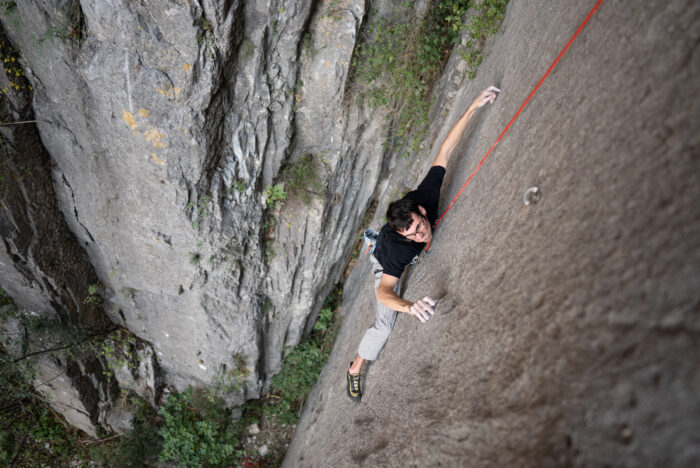
Trad
Traditional climbing routes usually follow cracks and fissures in the rock. Climbers jam their hands and feet in these cracks while climbing, and trad climbing shoes are designed with this application in mind.
Footjams tend to work best with shoes that have a semi-flat profile and are not aggressively downturned. Jamming with aggressive or severely tight shoes is unpleasant and not especially effective.
On this list, the La Sportiva TC Pro and the Katana Lace offer a low-profile toebox that can squeeze into narrow fissures.
Of course, steep and powerful trad routes exist too, and sometimes aggressive shoes actually are your best bet. As always, picking shoes for the job is not a perfect science. It’s wise to be flexible with your shoe choice. Sometimes trad climbing calls for aggressive shoes, and sometimes bouldering calls for flat and stiff shoes.
Sport
Sport climbing comes in all angles and difficulties. Technically, sport climbing refers to a climbing ethic rather than a specific style. The word “sport” means something slightly different as far as shoes are concerned.
When shoes are marketed for sport climbing, they’re usually soft and aggressive, just like a pair of bouldering shoes. However, many sport climbing routes are not severely overhanging.
There are all kinds of sport routes out there. On vertical to slightly overhanging terrain, you’ll likely want a relatively stiff shoe with only a slight downturn like the SCARPA Boostics. On steep powerful routes like those found in Rifle, CO or El Salto, Mexico, go with a softer, more downturned shoe like the SCARPA Drago or the La Sportiva Solution Comp.

Stiff vs. Soft
Every climbing shoe exists on a spectrum from soft to stiff. A shoe’s stiffness comes from its construction. Thicker material — especially soles and midsoles — results in stiffer shoes. Meanwhile, thinner materials create a softer and generally more sensitive shoe.
The stiff/soft spectrum works just like hiking boots. Stiffer shoes offer more support and help prevent foot fatigue and soreness. Softer shoes are more pliable and sensitive, allowing you to feel the nuanced texture of the rock through the sole and manipulate the shape and position of your foot.
When the route requires you to stand on lots of minuscule footholds in more vertical terrain, stiffer shoes are most effective. For smearing or bouldering on severely overhanging rock, softer shoes are the go-to choice.
On this list, the SCARPA Boostic R, the La Sportiva Katana, and the La Sportiva TC Pro are great stiffer shoes that can handle tiny footchips and nubbins with ease. The La Sportiva Solution Comp and the SCARPA Drago are both soft shoes. They won’t work as well on technical and vertical terrain, but they are perfect for steep overhangs or indoor competitions.
Shoe Profile: Aggressive vs. Flat
Aggressive climbing shoes have a downturned shape that looks and feels similar to a claw. Thanks to this shape, aggressive shoes are great for climbing overhanging rock. Usually, aggressive shoes are also better for toe hooking and heel hooking.
Flat shoes tend to be more comfortable than aggressive shoes, as they keep your foot in a more neutral position. Flat shoes are great for beginners.
When climbers are just starting out, an aggressive profile will probably create more pain and distraction than actual climbing benefits. For this same reason, flat shoes are most climbers’ preferred option for all-day multipitch excursions. The TC Pro and the SCARPA Generator are both relatively flat and designed for all-day edging. The SCARPA Arpia is only slightly downturned, is is also comfortable enough to wear on longer climbs.
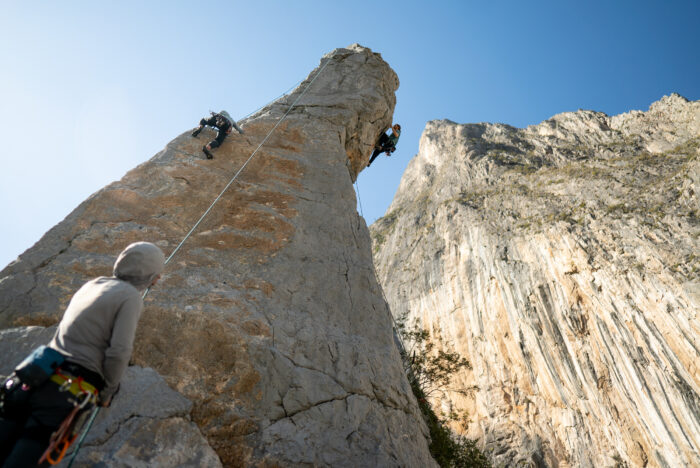
Asymmetry
When a shoe is described as “asymmetrical,” manufacturers are referring to the shape of the shoe. A highly asymmetric shoe will curve inward at the toe and look almost banana-shaped. A highly asymmetric shoe like the Scarpa Drago will focus more power on the big toe to facilitate edging and overall sensitivity. The drawback here is comfort since the human foot is not shaped like a banana.
A shoe for all-day wear like the TC Pro or Scarpa Generator is much less asymmetric and generally more comfortable, while the Scarpa Instinct Line, Sportiva Solutions, and Katatanas lay somewhere in the middle. The degree of asymmetry you can handle is dependent on your foot shape, and folks with Morton’s toe tend to suffer in more asymmetric shoes.
Too much time in these sticky rubber foot binders could even cause you to develop bone spurs or hammer toe. Your best bet is to try on as many shoes as you can when you get the chance in a shop. Keep in mind that a softer asymmetric shoe (again, like the Drago) will be a bit more forgiving, whereas a stiffer model will only break in so much.
Closure System
Rock climbing shoes typically feature one of three closure-system styles: laces, Velcro, or slippers. Some shoe models, like the Evolv Defy, come in more than one closure style. Though a closure system may seem like a minor detail, it can actually be an important factor to consider when choosing climbing shoes.
Laces
Laces are the classic closure system for just about all kinds of footwear. On climbing shoes, laces require a little extra time compared to Velcro or slippers. That said, laces allow you to thoroughly customize the fit of your climbing shoes.
For example, climbers with a wide toebox can keep the laces in that area slightly looser to accommodate their foot shape. Lace-ups are versatile. They can be kept loose for long multipitch routes or cinched up aggressively for increased precision.
Velcro
Velcro closures are quick and efficient to use. However, it can be difficult to create a precise fit with only a few straps. Also, Velcro straps can sometimes hinder a shoe’s toe hooking ability and can come undone while foot jamming in cracks.
On this list, the SCARPA Boostic employs a unique closure system that integrates the shoe’s straps directly into the structure of the shoe. The result is an impressively customizable fit.
Slippers
A well-fitted pair of climbing slippers can be comfortable, convenient, and excellent for smearing and jamming. However, because slippers rely on elastic fabric to create a precise fit, they tend to stretch out and become less effective over time.
We’ve had some luck with the Scarpa Instinct S. These slippers offer precise edging and fairly secure heel hooking with the comfort of a slipper. For more traddy applications (Jamming!), we recommend the Scarpa Vapor S for its low profile toe and wide toebox for jamming comfort.
The La Sportiva Solution Comp is essentially a slipper, though it does have a single Velcro strap which helps maintain the shoe’s integrity over time.

Parts of a Climbing Shoe
The primary parts of a climbing shoe are the sole, midsole, closure system, rand, and upper. Each part has a specific role to play in the shoe’s construction, and each can have an effect on overall performance.
Upper
The largest component of a climbing shoe’s construction is called the upper, which covers the top and sides of your foot. Climbing shoe uppers are made of either leather or synthetic material. Neither is strictly better, but they each have unique strengths and weaknesses.
Leather uppers stretch and conform to the shape of your foot. If you’re interested in a shoe made from leather, you can purchase a slightly smaller size under the assumption it will stretch and expand.
On this list, the La Sportiva TC Pro is built with a robust leather upper. Though the TC Por feels a bit stiff and uncomfortable right out of the box, it will stretch and become well-fitted over time.
Synthetic uppers do not stretch, and they will generally maintain their original shape in the long term. When purchasing synthetic shoes, it’s important to make sure you buy the exact size and fit you want, as it will not change over time.
Another benefit of synthetic uppers is they can be quite thin without sacrificing durability. On this list, the SCARPA Boostic R includes a very thin, lightweight upper made from Alcantara fabric. This subtle feature adds sensitivity to the Boostic’s performance without adding weight or decreasing durability.
Climbing Shoe Rubber
As a primary point of contact between the climber and the rock, the rubber outsole is a crucial part of any climbing shoe.
All climbing shoes feature sticky rubber soles. As a general rule, soft and thin rubber outsoles are better for steep routes and bouldering. Soft rubber is stickier, and the thinner the outsole, the easier it is to feel the texture of the footholds underfoot.
While soft and thin outsoles can be great, they also tend to wear out quickly. It’s a bummer to pay $200+ for a shoe that runs out of rubber after 4 months — but that’s the price climbers pay for top-notch performance.
On the other end of the spectrum, harder, thicker outsoles are ideal for vertical routes with tiny footholds. On the famous Dawn Wall on El Capitan, Tommy Caldwell and Kevin Jorgeson utilized La Sportiva TC Pros with firm rubber outsoles to stick to minuscule quartz crystal footholds. Harder rubber compounds also tend to last longer before they require resole or replacement.
Some shoe manufacturers make multiple types of rubber for various climbing applications. For example, some La Sportiva shoes include XS Grip 2 rubber, while others include XS Edge. The softer, rubber-like XS Grip is ultra-sticky and soft, but also wears down quickly.
Meanwhile, the slightly harder XS Edge rubber is less sticky but a bit more durable in the long term. Many other shoe brands, including Tenaya and SCARPA, also use XS Edge and XS Grip rubber.
There is a lot of debate in the climbing shoe world about which shoes have the best rubber. All of the shoes we have included on this list come with quality, highly capable sticky soles.

Fit and Sizing
Properly fitting a pair of climbing shoes is a puzzling task. Every shoe manufacturer seems to fit their shoes according to their own unique system. Often, sizing will even vary from style to style within a single brand’s lineup. Ideally, the best way to choose the right size is to physically try on the shoes.
How tight or loose to wear climbing shoes will depend on your needs as a climber. Generally, climbers like to fit their shoes tightly when trying routes that are challenging for them.
A tight fit ensures minimal negative space within the shoe. A tightly fitted shoe will slightly curl the toes, which helps to channel power into the toe edge when standing on small footholds.
However, the performance benefits of tightly fitted shoes come at the cost of discomfort. Your feet do not want to be held in an unnatural position, and tight shoes will need to be regularly taken off during your session to give your feet a break.
There is nothing wrong with sizing your climbing shoes for comfort. Beginner climbers especially should prioritize comfort over an aggressive fit. For long sessions at the gym or all-day multipitch routes, you don’t want to worry about nagging pain and foot cramps.
Recently, SCARPA has released many fit variations to their popular Instinct and Drago lines, so if you really like one of those shoes, you can try low volume versions of them with more narrow heels. Sportiva has re-classified their men’s and women’s shoes in “regular” and “low-volume” versions, acknowledging that many men will choose the women’s model if they fit better, and vice versa. The low volume version of the Katana Lace has a split midsole for lighter climbers, or climbers looking for more sensitivity than the regular version of the Katana.
Price & Value
We remember when climbing shoes ran from $60 to $130. These days you’re looking at $90 all the way up to $220 for a pair of shoes that hurt when you first put them on and blow out after half a year of climbing. Not quite as bad as the situation with ski boots, but still pretty rough.
We can honestly say that climbing shoes have gotten a lot better since the early 2000s. They used to be incredibly painful if you sized them down enough to edge effectively. Modern shoes from La Sportiva, Scarpa, and Teneya all feature designs that maximize comfort and performance (mostly) without deforming your feet.
If you don’t climb a lot, you’ll probably be happy in flat-lasted, inexpensive shoes. If you lay in bed at night with your palms sweating while envisioning the crux move on your project, it’s worth investing in a good pair of shoes, regardless of your skill or experience level.
Budget
Budget shoes are often flat-lasted, completely synthetic, and have symmetrical lasts. They’re usually pretty comfortable if sized correctly. Budget shoes like the La Sportiva Tarantulace ($89) will do the trick on your early forays into the gym, but outside, the synthetic uppers won’t hold up as well as more expensive leather shoes, especially if you’re climbing a lot of cracks.
The SCARPA Arpia V ($170) is an excellent value. It’s comfortable for all-day climbing and durable enough, considering the price. It doesn’t climb a well as our other top picks, but it’s perfect for training and getting in easy mileage.
Mid-Tier
The majority of the shoes in this guide sit in the middle price range from $150 to $200. Here you’ll get modern features like 3D molded heel cups that stay secure for heel hooking, fully leather uppers for durability, and designs that increase performance and reduce foot pain.
The SCARPA Vapor Lace ($199) is a versatile shoe for trad and sport, with a rubber patch on the toebox for durability while crack climbing. This shoe is not all that different from our top pick, the La Sportiva Katanas, and if it fits you better than the Katanas, it’s a great choice for a “quiver of one” shoe.
Premium
$200+ is the trend for top-tier climbing shoes. Many from Scarpa and La Sportiva are designed and manufactured in Italy, with leather or soft and durable Lorica. They do tend to last longer and are resoled a lot better. In fact, La Sportiva has made lasts, rubber, and specialized rubber pieces available to certified resolers to increase its shoes’ longevity and promote sustainability.
In general, you’ll get a lot more life out of the more expensive shoes. Our favorite models, such as the Katana ($219), TC Pros ($219), and Instinct S ($209), all fall into the premium price tier.

Frequently Asked Questions
The best climbing shoes are the ones that best fit your needs as a climber. All of the shoes on this list are great options, and we have included models that are well-suited to various climbing disciplines.
Unless you are absolutely sure the recipient will fit into a specific style and size of climbing shoes, it’s best to have them try shoes on before purchasing. If you’re looking for climbing shoes for a beginner climber, the La Sportiva Tarantulace is an excellent choice.
Climbing shoes range from around $75-230 per pair.
Climbing shoes with thicker soles and heavier materials, like the La Sportiva TC Pro, tend to last longer than softer, thinner shoes. That said, a regularly worn pair of climbing shoes will last between 3 months and 2 years. The rubber outsole of a climbing shoe usually wears out first, but rubber can be replaced by a qualified resoler for around $60.
If fitted appropriately, climbing shoes can be quite comfortable. Every climber has their own unique fit preferences. While a tighter fit tends to offer the highest level of performance for elite climbers, it’s not always necessary to wear uber-tight climbing shoes. For beginner and intermediate climbers, we recommend prioritizing comfort over an aggressive fit.
Many advanced climbers choose to punish themselves with painful, foot-binding shoes. It’s common, but not necessary (for most of us).

The Best Climbing Helmets of 2024
Whether you’re headed to the sport crag or a distant alpine big wall, every climber’s kit should include a helmet.

The Best Climbing Harnesses of 2025
We found the best climbing harnesses of 2025. Whether you’re sport climbing or mountaineering, we have you covered.



